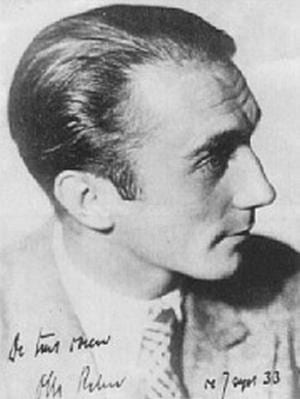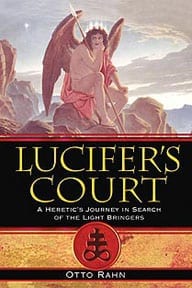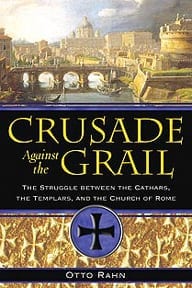Otto Rahn Bio

Berlin between the wars was a city known throughout Europe for its bohemian subculture of young intellectuals. Amongst the personalities who hotly debated the many modernist “isms” that were fracturing the old ideological certainties that had glued together the 19th century, few individuals were more colorful or conspicuous than a febrile dark-haired, green-eyed young man called Otto Wilhelm Rahn.
Rahn was welcomed in the cafes and nightclubs of 1930’s Berlin because he was a hyper-intense intellectual – a brilliant talker with a great deal to say but he was also a conspicuous outsider in that he was unfashionably dismissive of the emergent modernism that so excited his peers. Moreover, he had even less empathy with the cynicism and decadence that colored there lifestyle. Rather, like that of most Germans outside of Berlin, Rahn’s sensibility had been molded by influences wholly incompatible with the café society avante-garde.
 Otto Rahn was born in the small town of Michelstadt in Southern Germany on February 18th, 1904. A solitary, introverted boy, he assimilated the bare bones of German Romanticism through avid childhood reading of Greek, Roman and Nordic myths and legends. In addition to this, all around him the romantic spirit was alive and well in the Rambler’s Associations and Mountaineering Clubs which began to flourish around this time. For Rahn, this generalized affinity with romanticism became refined into an all consuming obsession with the legends of Parsifal, the Holy Grail, Lohengrin, and the Nibelungenlied. While attending the University of Giessen, he was inspired by his professor, Freiherr Von Gall, to study the Albigensian (Catharism) movement, and the massacre that occurred at Montségur. Rahn is quoted as saying that "It was a subject that completely captivated me''.
Otto Rahn was born in the small town of Michelstadt in Southern Germany on February 18th, 1904. A solitary, introverted boy, he assimilated the bare bones of German Romanticism through avid childhood reading of Greek, Roman and Nordic myths and legends. In addition to this, all around him the romantic spirit was alive and well in the Rambler’s Associations and Mountaineering Clubs which began to flourish around this time. For Rahn, this generalized affinity with romanticism became refined into an all consuming obsession with the legends of Parsifal, the Holy Grail, Lohengrin, and the Nibelungenlied. While attending the University of Giessen, he was inspired by his professor, Freiherr Von Gall, to study the Albigensian (Catharism) movement, and the massacre that occurred at Montségur. Rahn is quoted as saying that "It was a subject that completely captivated me''.
In 1931 he traveled to the Pyrenees, a mountainous region of southern France where he conducted a large amount of his research. Aided by the French historian, and the Minister of Tourism for Ussat-Les-Bains, Antonin Gadal, Rahn theorized that there was a direct link between Montsalvat, the Grail castle of Wolfram Von Eschenbach's Parzival and the fortress of Montsegur which was one of the last Cathar strongholds to fall and the site of one of the most protracted sieges of the Albigensian Crusade.
Rahn believed that the culture of the medieval Cathars bore a strong resemblance to the ancient Druids, who in Britain had been the forerunner of the Celtic Christian Church. Their priests were akin to the Cathar Parfaits, whose secret wisdom was preserved by the later Troubadours, the travelling poets and singers of the medieval courts of France.
Rahn wrote two books linking Montségur and the Cathars with the Holy Grail: Kreuzzug gegen den Gral (Crusade Against the Grail) in 1933 and Luzifers Hofgesind (Lucifer's Court) in 1937. According to his French translator, Rahn believed that the Cathars were last owners of the Holy Grail and that the Grail had perished when their faith had been stamped out by the Holy Roman pope and the Kings of France at the beginning of the 13th century. The war of the Roman Catholic Church against the Cathars is described as a final conflict between Roma and Amor in which the Catholic (‘common’) idea triumphed with flame and sword over the catharic (‘pure’) idea.
The medieval Cathars believed in the existence of an eternal war between the principles of Light and Darkness on whose meetings and encounters everything in the universe was based. Darkness was for them dark matter, the unperfected, the transient. They identified all clerical and secular rulers, principally the Catholic Church as the personification of this Darkness. In their mythology the sun symbolized the primordial Light from which all life emerged. The racial theorist, Miguel Serrano, termed their doctrine “Solar Kristianity”. For Rahn Montsegur was the “lighthouse of Catharism”.
After the publication of his first book, Rahn's work was brought to the attention of the Reichsfurher SS Heinrich Himmler by the head of the Race and Settlement Department, Karl Maria Wiligut-Weisthor, an expert in Germanic pre-medieval history, runes, magic and the occult.
 Rahn joined Himmler’s staff as a junior non-commissioned officer and became a full member of the SS in 1936. For his second book, The Court of Lucifer, Rahn travelled and wrote about places in Germany, France, Italy, and Iceland.
Rahn joined Himmler’s staff as a junior non-commissioned officer and became a full member of the SS in 1936. For his second book, The Court of Lucifer, Rahn travelled and wrote about places in Germany, France, Italy, and Iceland.
When speculative rumors surfaced of Otto’s possible homosexuality, which may have caused him to fall out of favor with the Nazi leadership, he was assigned guard duty at the Dachau concentration camp in 1937 as a possible punishment. After a reportedly staged marriage failed to ‘rehabilitate’ him in the eyes of his superiors, Otto resigned from the SS in 1939. He wrote: "There is much sorrow in my country. Impossible for a tolerant, liberal man like me to live in the nation that my native country has become."
The circumstances of Rahn’s death remain a mystery. The last people to see him alive were the children of a Tyrolean farmer who claim a man dressed in black emerged from the treeline outside their cottage on March 13th, 1939 and asked if they knew the time. Later the stranger vanished into the storm apparently leaving no footsteps despite the fact that the snow was already a meter deep. The next spring while playing in the woods the children came across the badly decomposed body that was later identified by the SS as that of the missing Grail historian, Otto Rahn. Next to his body lay two medicine empty medicine bottles. Whether he was a victim of foul play or had voluntarily chosen to leave a world he saw disintegrating around him remains a matter of speculation.
- Войдите или зарегистрируйтесь, чтобы получить возможность отправлять комментарии
Similar By Terms
|
(English)
|
(English)
|
(Deutsch)
|
(Español)
|
|
(English)
|
(Deutsch)
|
(English)
|
(English)
|








Последние комментарии
13 лет 41 неделя назад
13 лет 42 недели назад
13 лет 42 недели назад
13 лет 42 недели назад
13 лет 45 недель назад
13 лет 51 неделя назад